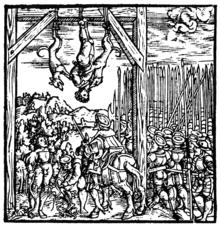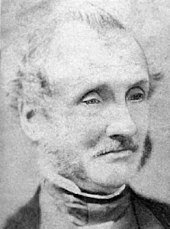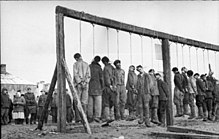Hang

When hanging or hanging (veraltend also: Henken ) the killing by constriction of the neck or breaking the nape in a - - mostly current loop designated under the influence of body weight. Hanging is one of the most common methods of suicide and one of the oldest types of execution . Strangulation is the forensic generic term for hanging, strangulation or strangulation .
A special form that has nothing to do with strangulation was the “ Jewish punishment ”, or hanging on the feet, which was practiced on Jews in the early modern period.
variants
A distinction is made between three variants. They are characterized by the way the rope and the gallows are constructed.
Short case
In the short case, the convict is positioned on a car, cart, horse or other object in such a way that this object can be moved away from under him. By compressing the arterial vessels in the neck, i. H. the carotid arteries and the vertebral arteries, an immediate cessation of blood flow to the brain occurs, which leads to unconsciousness within 5 to 10 seconds. Your own body weight is more than sufficient to cause these vessels to close. Congestion only occurs when the compression is not complete, which is usually not the case with free hanging. Death occurs as a result of the lack of oxygen in the brain, which leads to irreversible damage after just 3–5 minutes. Before 1850 this method was mainly used.
Standard case
This variant appeared in England in the 1860s. The height of fall was between 1.20 and 1.80 meters. Scientific details about this method were published by the Irish doctor Samuel Haughton .
Long case
In 1872 a new form of hanging was introduced by William Marwood , which was considered a scientific improvement over the standard case. The length of the rope was determined based on height and weight so that the delinquent 's neck was broken, but beheading avoided.
Medical aspects
For a long time it was assumed that hanging or hanging leads to a painless death in a short time. For the method without a broken neck, however, this could be refuted by forensic medicine attempts by Nicolae Minovici at the beginning of the 20th century. Accordingly, the interruption of the blood supply to the brain leads to considerable pain.
suicide
In forensic medicine, a distinction is made between typical and atypical hanging. In typical hanging, the body hangs in a free-floating position; the hanging point, which can be detected via the cord groove, is at the back in the middle of the neck. When hanging atypically, for example, the sitting or lying body partially touches the ground, the suspension point is then mostly shifted to the side or at the front of the neck.
Executions
In the Middle Ages and early modern times, hanging was similar to slow strangling : the weight of the body pressed the rope onto the Adam's apple , the thrush, and thereby constricted the windpipe .
In Austria-Hungary it was customary to lift the delinquent by an alignment pole, put the noose around his neck and then pull the body down with a jerk. This compressed the carotid arteries and vertebral arteries . Sometimes the base of the tongue pressed against the back of the throat and blocked the airways. The convict quickly lost consciousness and died due to the interruption of the blood flow in the brain (the venous outflow of the blood is also stopped by the external compression).
If the long drop is used on the gallows (as in Great Britain until the death penalty is abolished ; currently still in some US states , Singapore , Malaysia , Kuwait and Iraq ), the convicted person falls through a suddenly opened trap door in the ground after the rope length calculated depending on his weight and build, about 1.5–2.6 meters before the rope suddenly slows down the fall. The intended, but not always occurring, consequence is a fracture of the dens axis ( neck fracture ), whereby the displacement of the fragments of this bone is intended to squeeze the medulla oblongata (elongated marrow) and thus damage the central circulatory and respiratory centers. This type of hanging often leads to post-mortem erections in men . Otherwise, from a neurophysiological perspective, it has the same effect as decapitation . If the rope is too long, the head may tear off (as in the case of Barzan Ibrahim at-Tikriti ); if it is too short, the convict may not pass out immediately.
Penal system (death penalty)
In the penal system , executions are usually carried out by hanging on a gallows .
In the past, hanging was also called "judging with a dry hand" in contrast to decapitation, "judging with a bloody hand". In ancient times, killing by hanging - in contrast to beheading - did not require any special skill. This made the search for executioners easier.
In contrast to the honorable beheading , which was mostly reserved for convicts of higher rank, the dishonorable hanging was granted to such lower social rank or bird-free ones , who were then often left to the birds to feed on the gallows. This partly continued into the 20th century. The Nazi judiciary left many resistance fighters against the Hitler dictatorship hanging. The death sentences imposed by the Nuremberg Tribunal were also "death by hanging".
This form of the death penalty in the United States was last carried out on January 25, 1996 on Billy Bailey in Delaware .
A case from Brilon is known from the 17th century , in which a deceased delinquent was hanged.
Special shape

In early modern times , Jews were supposed to hang upside down on their feet, the so-called Jewish punishment , whereby dogs were often hanged as a tightening, as a woodcut from the Swiss Chronicle by Johann Stumpf published in Augsburg in 1586 shows. This was also done to force the delinquent to convert to Christianity . If he did so, the sentence was changed to beheading and the corpse was buried regularly.
Superstition
If the corpses remained on the gallows, parts of the corpses were removed, because their “rogue legs” (bones) or “ arm sinners lard ” (fat) were considered medicinal and magical in the Middle Ages. A thief's thumb, for example, was supposed to bring luck in the game, and the gallows rope was used to tame wild horses. Of mandrakes , which were also used for magical practices, it was believed that they would result from dripping urine and semen of hanged. They were therefore also called "hangman".
literature
- Richard J. Evans : Rituals of Retribution. The death penalty in German history 1532–1987 . Kindler, Berlin 2001, ISBN 3-463-40400-1 (Original title: Rituals of retribution . Translated by Holger Fliessbach).
- Heiner Lück : Gallows . In: Albrecht Cordes , Heiner Lück, Dieter Werkmüller , Ruth Schmidt-Wiegand (eds.): Concise dictionary on German legal history , Aachen-Geistliche Bank . 2nd, completely revised and enlarged edition. tape 1 . Erich Schmidt Verlag, Berlin 2008, ISBN 978-3-503-07912-4 , Sp. 1917-1926 .
-
Charles Duff : A Handbook on Hanging . The History Press, Stroud 2011, ISBN 0-7524-6068-4 .
- Charles Duff: Executioner's Guide. A family and edification book. A brief outline of the art of hanging. Translated from English by Gertrud Reyersbach. Preface by Léo Lania . Schultz, Berlin 1931, DNB 572932375 .
- VAC Gatrell: The Hanging Tree, Execution and the English People 1770-1868 . Oxford Univ. Press, Oxford / New York 1996, ISBN 0-19-285332-5 .
- Fred Harvey Harrington: Hanging Judge . University of Oklahoma Press, Norman 1996, ISBN 0-8061-2839-9 .
- Traugott Vitz: long rope, quick death. How Britain hanged its killers . Verlag Kirchschlager, Arnstadt 2016, ISBN 978-3-934277-66-3 .
- R. Michael Wilson: Legal Executions in the Western Territories, 1847-1911. Arizona, Colorado, Idaho, Kansas, Montana, Nebraska, Nevada, New Mexico, North Dakota, Oklahoma, Oregon, South Dakota, Utah, Washington and Wyoming . Mcfarland & Co Inc., Jefferson, NC 2010, ISBN 0-7864-4825-3 .
Web links
- Hanging . In: Meyers Konversations-Lexikon . 4th edition. Volume 5, Verlag des Bibliographisches Institut, Leipzig / Vienna 1885–1892, p. 780.
- The Austrian gallows. In: todesstrafe.at, 2003 (description and illustration of the Austrian alignment stake for strangulation)
- Execution of Saddam's Half-Brother: What Mistakes the Executioner Must Have Made. In: Spiegel Online . January 15, 2007 (Report on the poorly executed hanging of Barsan al-Tikritis)
Individual evidence
- ↑ hen | ken (weak verb; perfect formation with "has"; obsolete), from mhd. , Ahd. Henken = to hang; (hanging; hang . In: duden.de, (last) accessed on June 1, 2016.
- ↑ a b Wolfgang Schild: The history of jurisdiction . Nikol Verlagsgesellschaft, Hamburg 1997, ISBN 3-930656-74-4 , p. 66 . License from: Verlag Georg DW Callwey, Munich 1980.
- ↑ Series: Curious Experiments on Humans: Hanging for Science. Retrieved June 3, 2019 .
- ^ Burkhard Madea: Forensic Medicine. 3. Edition. Springer, Berlin / Heidelberg 2014, ISBN 978-3-662-43499-4 .
- ↑ Series: Curious Experiments on Humans: Hanging for Science. Retrieved June 3, 2019 .
- ↑ Gerd Althoff , Hans-Werner Goetz , Ernst Schubert : People in the shadow of the cathedral . Primus Verlag, Darmstadt 1998, ISBN 3-89678-090-5 , p. 341 .
- ^ The history of judicial hanging in Britain 1735-1964. Drop tables. Retrieved November 8, 2012 (English, 5 feet (= 1.5 m) to 8 feet 6 inches (= 2.59 m)).
- ^ Arnold Melman and Elliot Letter: The Urologic Evaluation of Impotence . In: Helen Singer Kaplan (ed.): The evaluation of sexual disorders. Psychological and medical aspects . Brunner / Mazel, New York 1983, ISBN 0-87630-210-X , pp. 167 .
- ↑ See the article Melchior Berthold .
- ↑ Gerd Althoff, Hans-Werner Goetz, Ernst Schubert: People in the shadow of the cathedral . 1998, p. 339 .

